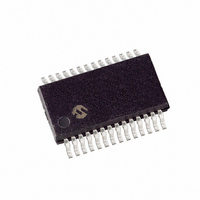PIC16F913-I/SS Microchip Technology, PIC16F913-I/SS Datasheet - Page 105

PIC16F913-I/SS
Manufacturer Part Number
PIC16F913-I/SS
Description
IC PIC MCU FLASH 4KX14 28SSOP
Manufacturer
Microchip Technology
Series
PIC® 16Fr
Datasheets
1.PIC16F616T-ISL.pdf
(8 pages)
2.PIC16F913-ISS.pdf
(330 pages)
3.PIC16F913-ISS.pdf
(8 pages)
4.PIC16F913-ISS.pdf
(34 pages)
Specifications of PIC16F913-I/SS
Core Size
8-Bit
Program Memory Size
7KB (4K x 14)
Core Processor
PIC
Speed
20MHz
Connectivity
I²C, SPI, UART/USART
Peripherals
Brown-out Detect/Reset, LCD, POR, PWM, WDT
Number Of I /o
24
Program Memory Type
FLASH
Eeprom Size
256 x 8
Ram Size
256 x 8
Voltage - Supply (vcc/vdd)
2 V ~ 5.5 V
Data Converters
A/D 5x10b
Oscillator Type
Internal
Operating Temperature
-40°C ~ 85°C
Package / Case
28-SSOP
Controller Family/series
PIC16F
No. Of I/o's
24
Eeprom Memory Size
256Byte
Ram Memory Size
256Byte
Cpu Speed
20MHz
No. Of Timers
3
Package
28SSOP
Device Core
PIC
Family Name
PIC16
Maximum Speed
20 MHz
Operating Supply Voltage
5 V
Data Bus Width
8 Bit
Number Of Programmable I/os
24
Interface Type
I2C/SPI/USART
On-chip Adc
5-chx10-bit
Number Of Timers
3
Processor Series
PIC16F
Core
PIC
Data Ram Size
352 B
Maximum Clock Frequency
20 MHz
Maximum Operating Temperature
+ 85 C
Mounting Style
SMD/SMT
3rd Party Development Tools
52715-96, 52716-328, 52717-734
Development Tools By Supplier
PG164130, DV164035, DV244005, DV164005, PG164120, ICE2000, DV164120
Minimum Operating Temperature
- 40 C
Lead Free Status / RoHS Status
Lead free / RoHS Compliant
For Use With
AC164307 - MODULE SKT FOR PM3 28SSOPXLT28SS-1 - SOCKET TRANSITION ICE 28SSOP
Lead Free Status / Rohs Status
Details
Available stocks
Company
Part Number
Manufacturer
Quantity
Price
Company:
Part Number:
PIC16F913-I/SS
Manufacturer:
INFINEON
Quantity:
201
Company:
Part Number:
PIC16F913-I/SS
Manufacturer:
Microchi
Quantity:
7 664
Part Number:
PIC16F913-I/SS
Manufacturer:
MIC
Quantity:
20 000
6.2.1
When the internal clock source is selected, the
TMR1H:TMR1L register pair will increment on multiples
of T
6.2.2
When the external clock source is selected, the Timer1
module may work as a timer or a counter.
When counting, Timer1 is incremented on the rising
edge of the external clock input T1CKI. In addition, the
Counter mode clock can be synchronized to the
microcontroller system clock or run asynchronously.
In Counter mode, a falling edge must be registered by
the counter prior to the first incrementing rising edge
after one or more of the following conditions:
• Timer1 is enabled after POR or BOR Reset
• A write to TMR1H or TMR1L
• T1CKI is high when Timer1 is disabled and when
6.3
Timer1 has four prescaler options allowing 1, 2, 4 or 8
divisions of the clock input. The T1CKPS bits of the
T1CON register control the prescale counter. The
prescale counter is not directly readable or writable;
however, the prescaler counter is cleared upon a write to
TMR1H or TMR1L.
6.4
A low-power 32.768 kHz crystal oscillator is built-in
between pins OSC1 (input) and OSC2 (amplifier output).
The oscillator is enabled by setting the T1OSCEN
control bit of the T1CON register. The oscillator will
continue to run during Sleep.
The Timer1 oscillator is shared with the system LP
oscillator. Thus, Timer1 can use this mode only when
the primary system clock is derived from the internal
oscillator or when in LP oscillator mode. The user must
provide a software time delay to ensure proper oscilla-
tor start-up.
TRISA7 and TRISA6 bits are set when the Timer1
oscillator is enabled. RA7 and RA6 bits read as ‘0’ and
TRISA7 and TRISA6 bits read as ‘1’.
© 2007 Microchip Technology Inc.
Timer1 is reenabled T1CKI is low. See Figure 6-2.
Note:
CY
as determined by the Timer1 prescaler.
Timer1 Prescaler
Timer1 Oscillator
INTERNAL CLOCK SOURCE
EXTERNAL CLOCK SOURCE
The oscillator requires a start-up and
stabilization time before use. Thus,
T1OSCEN should be set and a suitable
delay observed prior to enabling Timer1.
PIC16F913/914/916/917/946
6.5
If control bit T1SYNC of the T1CON register is set, the
external clock input is not synchronized. The timer
continues to increment asynchronous to the internal
phase clocks. The timer will continue to run during
Sleep and can generate an interrupt on overflow,
which will wake-up the processor. However, special
precautions in software are needed to read/write the
timer (see Section 6.5.1 “Reading and Writing
Timer1 in Asynchronous Counter Mode”).
6.5.1
Reading TMR1H or TMR1L while the timer is running
from an external asynchronous clock will ensure a valid
read (taken care of in hardware). However, the user
should keep in mind that reading the 16-bit timer in two
8-bit values itself poses certain problems, since the
timer may overflow between the reads.
For writes, it is recommended that the user simply stop
the timer and write the desired values. A write
contention may occur by writing to the timer registers,
while the register is incrementing. This may produce an
unpredictable value in the TMR1H:TMR1L register pair.
6.6
Timer1 gate source is software configurable to be the
T1G pin or the output of Comparator C2. This allows the
device to directly time external events using T1G or
analog events using Comparator C2. See the CMCON1
register (Register 8-2) for selecting the Timer1 gate
source. This feature can simplify the software for a
Delta-Sigma A/D converter and many other applications.
For more information on Delta-Sigma A/D converters,
see the Microchip web site (www.microchip.com).
Timer1 gate can be inverted using the T1GINV bit of
the T1CON register, whether it originates from the T1G
pin or Comparator C2 output. This configures Timer1 to
measure either the active-high or active-low time
between events.
Note:
Note 1: When switching from synchronous to
Timer1 Operation in
Asynchronous Counter Mode
Timer1 Gate
READING AND WRITING TIMER1 IN
ASYNCHRONOUS COUNTER
MODE
TMR1GE bit of the T1CON register must be
set to use the Timer1 gate.
asynchronous operation, it is possible to
skip an increment. When switching from
asynchronous to synchronous operation,
it is possible to produce an additional
increment.
DS41250F-page 103


















